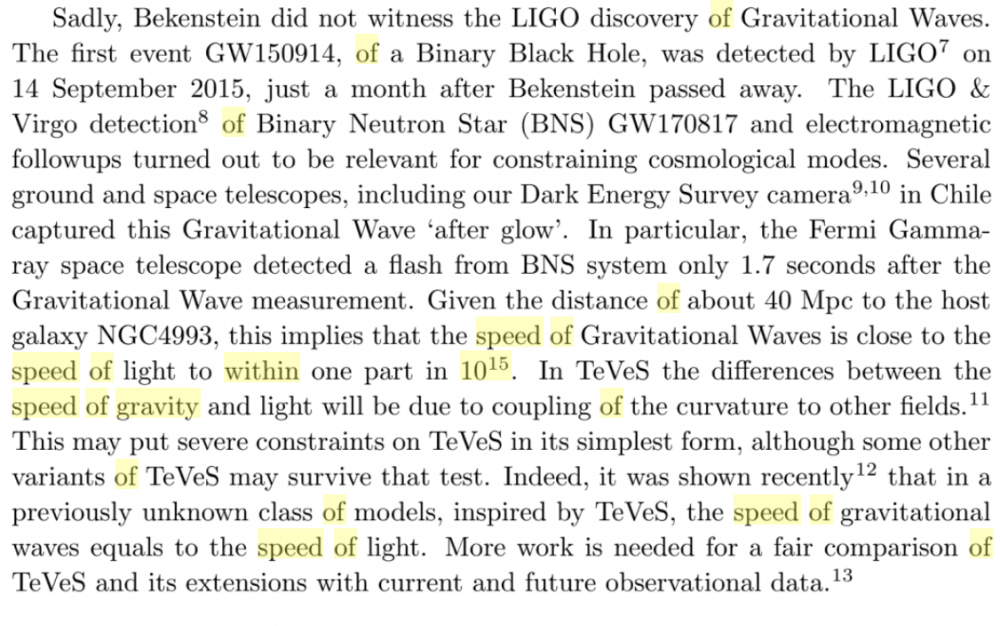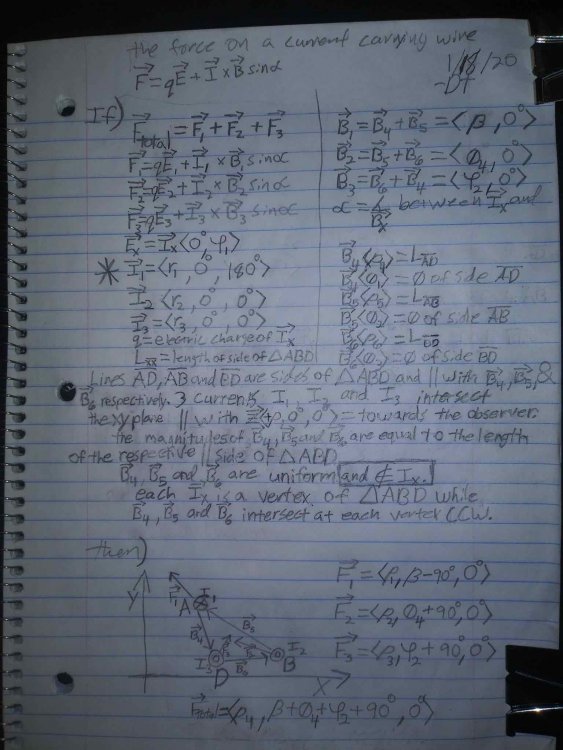-
Posts
2578 -
Joined
-
Days Won
21
Content Type
Profiles
Forums
Events
Everything posted by Ghideon
-
Is it OK to assume that ABD is an equilateral triangle?
-
I do not yet possess the knowledge to provide a comment on hidden variables and current physics theories in comparison to 60's radar technology. And since there is no source to be studied then I guess we're done.
-
Sorry, that it's not going to work in a science discussion. Why compare something to "particle precognition" if it looks like just some kind of made up thing that does not exist?
-
Can you please provide a reference, I'd like to check what I missed when studying antenna basics.
-
That was for gravitational waves alone, a comment added as a follow up to Sensei's note that delays, when registered, are useful. Then please read the whole post, the second source have better precision. Here is one reference documenting the observation of gravitational waves and electromagnetic radiation within approx 1.74 s. https://arxiv.org/abs/1710.05834
-
Please provide straight answers. Have you abandoned the first version of the lifter and wish to discuss only the new one? I am still looking at first version: You state that there is an acceleration. Acceleration relative to what?
-
Maybe not perfectly worded but worth a followup, delay of observation for gravitational waves are discussed in this paper: https://arxiv.org/abs/1602.04188 Combining gravitational signal and electromagnetic signal gives higher precision, distance to original source can be taken into account: https://books.google.se/books?id=du60DwAAQBAJ&pg=PA199 ... 1 in 10^15 is pretty good?
-
Thanks @Sensei
-
Why a new lifter, did you abandon the first one?
-
Can you provide a reference? That seems to contradict observations at LIGO: https://www.ligo.caltech.edu/page/press-release-gw170817 Future observations will probably add more details.
-
Are the magnetic fields generated in the lift or by another device, not onboard the lift? I assume that Ampère's force law can be neglected, correct? The currents do not generate a strong enough magnetic field to have an effect on the outcome.
-
Ok! Just so I follow: due to the force from the magnetic fields the rig will accelerate. How is momentum conserved?
-
Thanks for the picture. By what principle does the lifter work? Interaction with earth magnetic field, ejection of particles, other? Or is it is a proposal for a reactionless drive?
-

Only 10% of the Nobel prize winners are atheist ?
Ghideon replied to Daniel Wilson's topic in Religion
The second link in OP (https://emilkirkegaard.dk/en/?p=7237) states that the 10% claim is "bullshit". It does not support the 10% claim and gives several reasons why the number may be incorrect. Talk page of wikipedia "List of nonreligious Nobel laureates" states "The main source of this article is not reliable": https://en.wikipedia.org/wiki/Talk:List_of_nonreligious_Nobel_laureates#The_main_source_of_this_article_is_not_reliable Good points, I'll add a local example. Wikipedia lists 32 swedish laureates. During the years of Nobel Prizes Sweden have made several changes* to how church and state are related. Those reforms could impact what individuals would have answered at that time compared to more present times. It would require a lot of rigor to be able to produce reliable definitions and a usable list. This is just an example, for one single country, intended to highlight the difficulty with this kind of material. *) https://www.svenskakyrkan.se/church-and-state until year 2000 state and church was united Swedish only found: http://www.notisum.se/rnp/SLS/lag/19510680.htm Until 1952 you had to belong to a religious community, you could exit stat church only if you registered at another religious community. -
The word "lifter" seems to suggest that some force will accelerate something so that it lifts. It may help with an overview of what the magnetic lifter is before going into the details of the calculations. Edit: Pictures above are cropped. Instead of having to go to an external site each time I'll insert the picture here:
-

How is mass divided by volume to measure density ?
Ghideon replied to Complexity's topic in Speculations
No. Consider the following claim. Do you see that it seems to predict gravity to be negative? Instead of objects falling down on earth they should be ejected into space? Do you understand why? So either your claims are incorrect or very poorly worded. In either case that is not a good alternative to a few pages of physics and/or a good teacher. -

How is mass divided by volume to measure density ?
Ghideon replied to Complexity's topic in Speculations
Again: Are you discussing the moment a photon is radiated from some point. Or the photon along the path from A to B after it was radiated? It is tricky to try to write good answers since new questions and claims does not match what basic physics (observations and math) says. Again: What is your background knowledge? What concepts of math and physics are you familiar with that could act as a common starting point? It is completely OK to say "none" and then we start from explaining and providing references from there. -

How is mass divided by volume to measure density ?
Ghideon replied to Complexity's topic in Speculations
That seems to be completely incompatible with observations. Both for massive objects and photons. How many counterexamples can you find in a minute? -

How is mass divided by volume to measure density ?
Ghideon replied to Complexity's topic in Speculations
Because on the way A-B, why would there ever be a force involved to keep anything moving at constant speed in a straight line? If you have a photon going from a distant galaxy eventually ending up at a telescope on earth, are you suggesting that all along the way there are some force active that guides the photon? There is no such force. The photon does not accelerate. I think all this is already stated in earlier responses. Do you have a reason to believe that anything (light or other) needs a "reason" to traverse from A-B at constant speed? The physics is understood an modelled. As for the possible more philosophical meaning of "reason" I have no answer unless you provide some experiment that could be analysed. Note: If you are asking about the process of emitting light at point A, that is not included in the above. -

How is mass divided by volume to measure density ?
Ghideon replied to Complexity's topic in Speculations
Plenty of answers have been given. Again: There are so many interesting aspects of light that can be understood using various models depending on the level of details required or how deep one wants to go into a certain subject. But it requires some kind of common staring point. Personally I would not have been able to follow the university professor's explanations in the electromagnetic field theory course unless I had understod the math first. In this case, a starting point for invariant speed of light may be Maxwell. Problem is you are asking us to move back! Should we revisit Aether and Phlogiston as well? -

How is mass divided by volume to measure density ?
Ghideon replied to Complexity's topic in Speculations
Because light does not behave as water. Light needs other models and theories to be explained. There is no need to look at explanations that have been ruled or replaced by better theories. I have not read through much of the history of attempts at explaining light and electromagnetism but It is possible that Descarte's and Newton's ideas about "corpuscles" in 17th century would have included the forces you are asking about. But science moved on and this early forerunner to the modern understanding of the photon was replaced. Corpuscles theory didn't explain refraction and interference for instance. -
That may depend. Are the calculations based on physically correct assumptions? There seems to be things missing from the image (maybe formatting) so it is not easy to tell what the math is describing.
-

How is mass divided by volume to measure density ?
Ghideon replied to Complexity's topic in Speculations
Trying to catch up. And Seems to ask two different questions. First, Why is the light not as bright? You are probably familiar with photons. The list can be modelled as photons radiated away from the light source at the speed of light.The photons, unless they are absorbed (and maybe re-emitted) will continue in a straight line. Each individual photon is unaffected by the distance traveled. So each photon will reach, for instance and observer's eyes, at some distance. An observer closer to the light source will be hit by more photons per second and interpret it as bright light. An observer further away will be hit by fewer photons. This is kind of similar to an explosion, further away there is less risk to be hit by shrapnel. But important, each individual photon is not spread out. It is just that fewer photons will reach the observer that is further away. Second: What propels a photon on its way to the observer? Nothing. Since photons travel at constant speed there is no change in momentum requiring anything to push the photons. Photons are massless (and also not a material body as @studiot said above) they are not modelled using Newton's physics. Explaining further would require some more rigor than my crude attempts at analogies above. So again: -

How is mass divided by volume to measure density ?
Ghideon replied to Complexity's topic in Speculations
This is pretty far from the question I tried to help you with initially. Have to ask: What is your background knowledge? What concepts of math and physics are you familiar with that could act as a common starting point? Do you have a reference to something you read about light that raised the question? Your question needs more context to be answered. For instance, what is a "physical reality"? -

How is mass divided by volume to measure density ?
Ghideon replied to Complexity's topic in Speculations
Ok! Then lets try again. Ok, that has nothing to do with density as far as I can see. The volume of water and its mass and hence its density does not change when water is distributed in various locations around earth. Stationary running water on earth (lakes, oceans puddles) is AFAIK held in place by gravity. Same goes for any liquid or fluid on any celestial body. But the question is kind of complex if you want to consider other effects: Earth rotation. Tidal effects. Heat and cold, creating currents, rain, and running water. Water in the form of ice and snow But this was posted in Theoretical physics, so I guess this is not about earth science?




